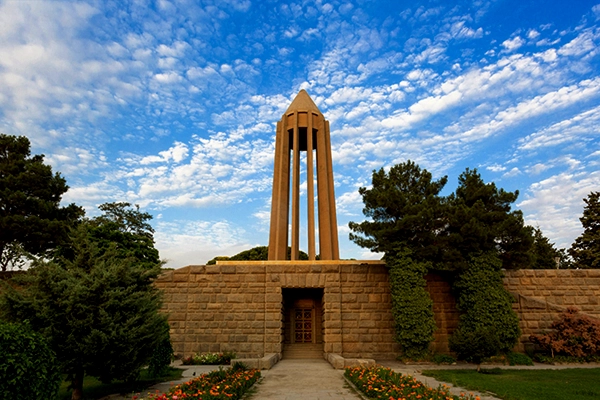
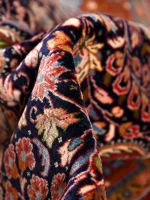
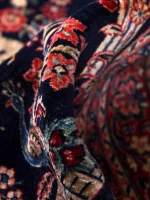
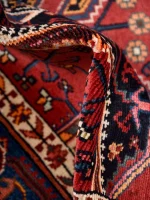
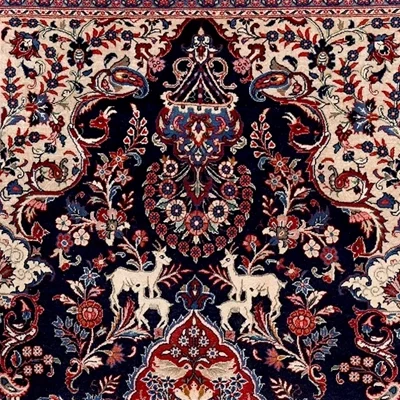
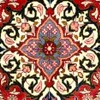
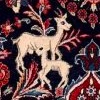
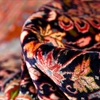
Behold the illustration of nature, which is engraved into this exquisite Persian Hamadan hand-knotted twin rug, crafted in 1965.
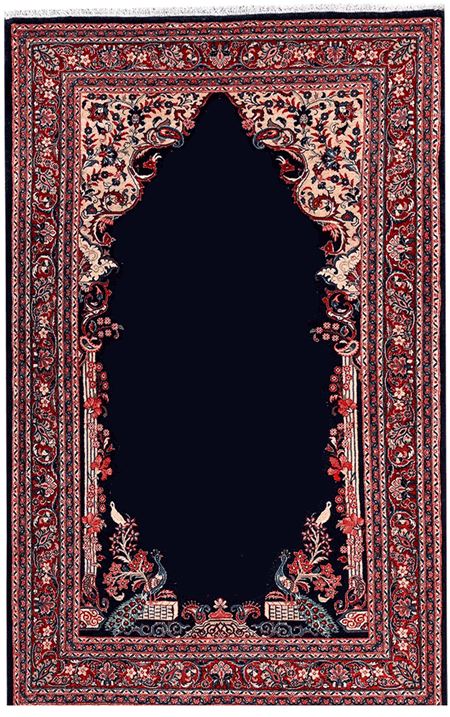
For over millennia, the people of Hamadan (Hamedan) have intricately woven the elements of nature into their hand-knotted rugs, illuminating the beauty and profound essence of life. Similar to Avicenna, the renowned scholar from Hamadan in 980 A.D., who drew inspiration from nature in his medicine, philosophy, and physics during the Samanid Empire, these skilled carpet artists have likewise transformed plants, animals, and natural phenomena into mesmerizing works of art.
The ancient weavers of Hamadan Persian Carpets showcased their intelligence and creativity by crafting visually captivating rugs. Using unique combinations of colors, particularly red and dark shades, they adorned these exquisite rugs with distinctive geometric patterns and depictions of specific animals.
The city of Hamadan is one of the ancient cities in Persia and is considered one of the oldest cities in the world. It is mentioned in the Christian holy book as Ecbatana. Persian Hamadan rugs, was widely beloved in the palaces of ancient Iranian and European empires. Nowadays, everybody has access to these rugs and can have this hand-woven piece of art at their home.
If you’re looking for a rug that continuously captures your attention, infusing a vibrant sense of vitality and the essence of life with every glance, take a look at our curated collection of Persian hand-woven rugs Persian Hamadan rugs since 1950.

Hamadan is a city with a rich historical background spanning over 2,700 years, tracing its roots back to the time of Diaoko, the founder of the Median Empire. Originally known as “Ecbatana,” it was chosen as the capital of Iran during that era before being renamed Hamadan.
This city played a prominent role as the primary hub for carpet trade in western Iran. The origins of Hamadan’s carpet industry can be confidently traced back to about 400 years ago. One of the most notable aspects of carpet weaving in Hamadan is the exquisite artistry found in its designs.
Due to its long winters and mountainous terrain, animal husbandry thrived in Hamadan. One of the primary occupations in the city and its surroundings has been the field of handicrafts, particularly carpet weaving.
hroughout history, Hamadan carpets have encompassed two distinct weaving styles: Shahr-Baf and tribal. Each type possesses unique characteristics, and it’s evident that, from a stylistic perspective, authentic Hamadan carpets are more intricately crafted and fall within the category of tribal rugs.
The carpet and rug weaving art, primarily carried out by women and girls, thrived in villages and tribal communities. Countless exquisite pieces were meticulously created using skilled fingers and specialized techniques. Simultaneously, men and women are engaged in this craft within urban workshops.
In Hamadan, the production of rugs and kilims, especially those offered at affordable prices, surpasses other carpet-weaving regions in the eastern lands. These rugs are crafted from the finest wools, sourced from local areas or neighboring regions like Shahsavan.
Examining Hamedan’s urban-style (Shahr-baf) rugs, it becomes apparent that they share significant structural similarities with Bijar rugs, albeit within a limited market.
The dimensions of Hamadan carpets typically fall within the following ranges:
150cm x 100cm (4’ 11.2” x 3′ 3.4″)
190cm x 120cm (6′ 2.8″ x 3′ 11.2″)
240cm x 150cm (7′ 10.5″ x 4′ 11.2″)
300cm x 200cm (9′ 10.1″ x 6′ 6.7″)
340cm x 250cm (11′ 1.8″ x 8′ 2.4″)
400cm x 300cm (13′ 1.5″ x 9′ 10.1″)
The wool used in Hamadan carpets is primarily sourced from the same region or neighboring provinces, such as Shahsavan, with the highest quality.
Tribal Hamadan rugs are typically woven using the Turkish knot technique and a single weft, which is fully visible on the back of the rug. The knots are flat and placed evenly. However, in urban Persian Hamadan rugs, the knots are woven in a double-knot technique.
The native identity of the region, encompassing housing styles, way of life, beliefs, and reverence for nature, is distinctly reflected in Hamadan carpets’ designs. This manifestation extends to parameters such as color, weaving technique, pattern, and even size, all of which hold significant importance.
Tribal carpets from Hamadan are woven in areas such as Malayer, Nahavand, Tuyserkan, Kabudarahang, and Asadabad and have gained global recognition. In addition, noteworthy regions for carpet production include Husseinabad, Angelas, Darjazin, Mazlaghan, and Berchalu. The distinctiveness of Hamadan Persian rugs styles and designs is evident through various patterns and colors in each region, creating a unique and undeniable identity for the Hamadan carpet tradition.
Hamadan city carpets have two wefts, with a knot count ranging between 30 to 40 knots per square inch. They are woven using the Turkish knot and have a (double-knot) structure.
Regarding knot type, durability, and strength, these Hamadan city rugs share similarities with Bijar carpets. They also resemble Sarouk carpets in terms of finesse.
Regarding coloring and dyeing, the ancient rugs of Hamadan are among the most beautiful and vibrant rugs in Iran. An exceptional harmony has been observed in these rugs, using natural colors. For instance, red is obtained from madder, natural green is derived from the grapes leaves, and various shades of blue are obtained from the indigo plant. Standard colors such as olive green, bright green, yellow, gold, orange, maroon, and camel brown are skillfully used in the professional and expert craft of Hamadan carpet weaving in urban areas.
Hamadan carpets were produced in two distinct styles: tribal and Shahr-baf weaving. These two styles were markedly different in terms of quality and appearance. However, what’s particularly significant here is the scarcity of Hamadan urban rugs in the market, attributed to their limited production.
Factors such as high-quality raw materials and the use of typically stable and appealing colors like indigo blue and madder red played a pivotal role in crafting these carpets. They were commonly featured in the designs of these rugs. The utilization of double knots also contributed to the strength and durability of this type of carpet.
Moreover, one of the most critical factors determining the value of these carpets was the use and creation of unique patterns. These patterns elevated Hamadan Shahr-baf rugs to the status of valuable artistic designs and masterpieces in the market. These carpets were not just floor coverings but also creative expressions of the skill and taste of the artisans.
It’s worth noting that the older and scarcer these rugs are, the more special their value becomes.
A simple geometric combination is featured in the woven carpet categories found in the villages of Hamadan, which draw inspiration from a mental pattern. These carpets usually consist of balanced colors and are often polygonal in shape. These patterns narrate stories of life and coexistence with nature. These artworks can also be observed in various regions, for example:
This diversity and beauty in various styles led all these carpets, whether under different names or patterns and designs, to be presented to the global market as “Persian Hamadan Rugs ” and gain popularity.
Handwoven rugs from Hamadan are skillfully crafted using locally sourced natural wool, particularly from the Khurramabad region. These woven treasures, made from natural wool, showcase exceptional quality and natural luster. The foundation of these rugs is composed of natural cotton threads, with no incorporation of synthetic elements like acrylic.
Two essential distinctions warrant attention:
In both cases, Hamadan’s rich rug-making tradition reflects the region’s unique craftsmanship and dedication to preserving natural materials in their weaving artistry.
A series of rugs over 100 years old, predominantly woven on woolen threads. In more recent rugs, cotton threads have been used for weaving, with their age ranging up to 60 years. Nearly 150 villages around Hamadan, extending deep into the Hamadan province, were all engaged in handcrafting rugs. This is why Persian Hamadan Rugs exhibit a wide variety of highly diverse styles. Overall, the rug-weaving tradition in Hamadan dates back approximately 400 years.
Relatively new Hamadan carpets are first treated with an acid wash and then exposed to sunlight. This method aims to give them an aged appearance and resemble old rugs. Unfortunately, due to the low quality of the raw materials and dyes, efforts are made to stabilize the colors, resulting in a faded and antique-like appearance. However, the reality is that Hamadan carpets intentionally made to look old do not possess the true authenticity and quality of a genuine antique Hamadan carpet.
Instead of artificially aging Persian Hamadan Rugs , you can purchase a semi-antique Hamadan carpet and enjoy the craftsmanship of the weavers.
Hamadan Shahr-Baf Carpets, which bear a similar structure to Bijar rugs and have an ancient history, can be valuable. Just as their designers and weavers differ, Hamadan Carpets are also handwoven and exhibit a high degree of diversity and style. Unique patterns that were once commissioned by wealthy families and passed down through generations are sometimes put up for sale for various reasons. If we only consider these Hamadan city rugs as floor coverings, it would be a mistake and a misinterpretation, missing out on an excellent investment opportunity. An example of this can be seen in Hamadan Shahr-Baf carpets with a peacock pattern, which a wealthy lady commissioned.
Get informed about exclusive sales , free delivery and discount coupons %